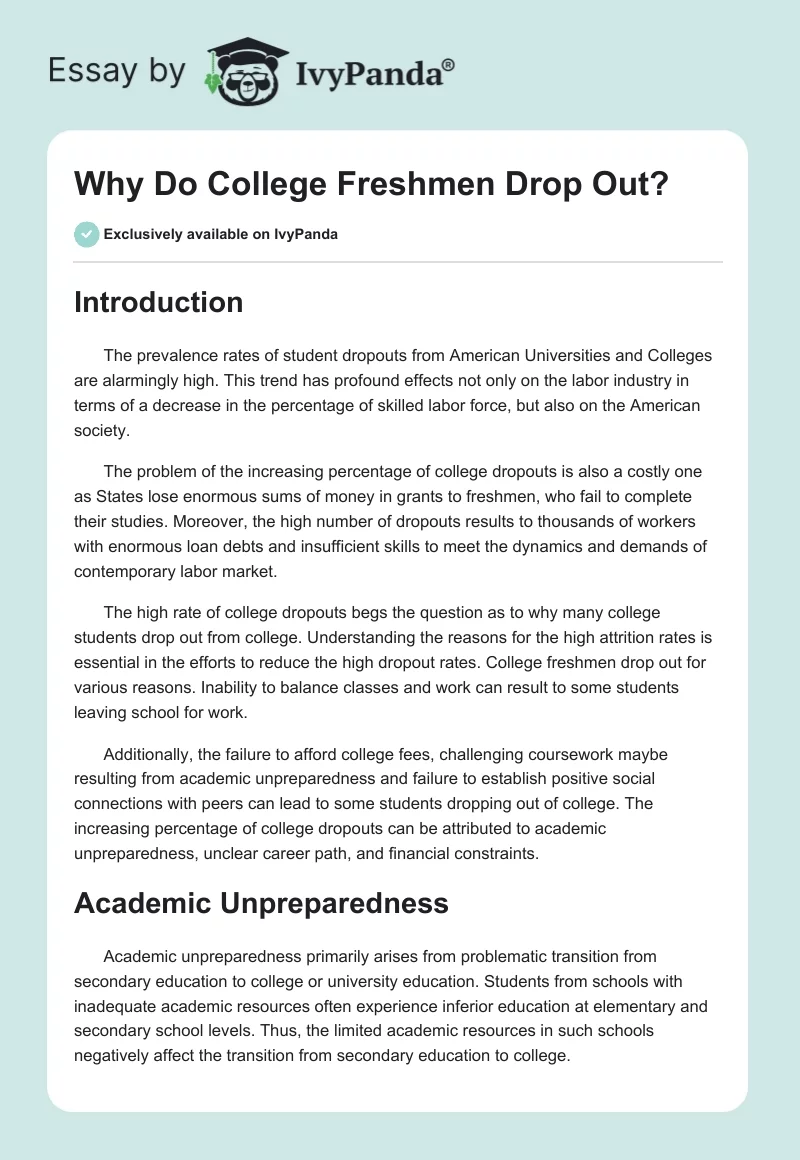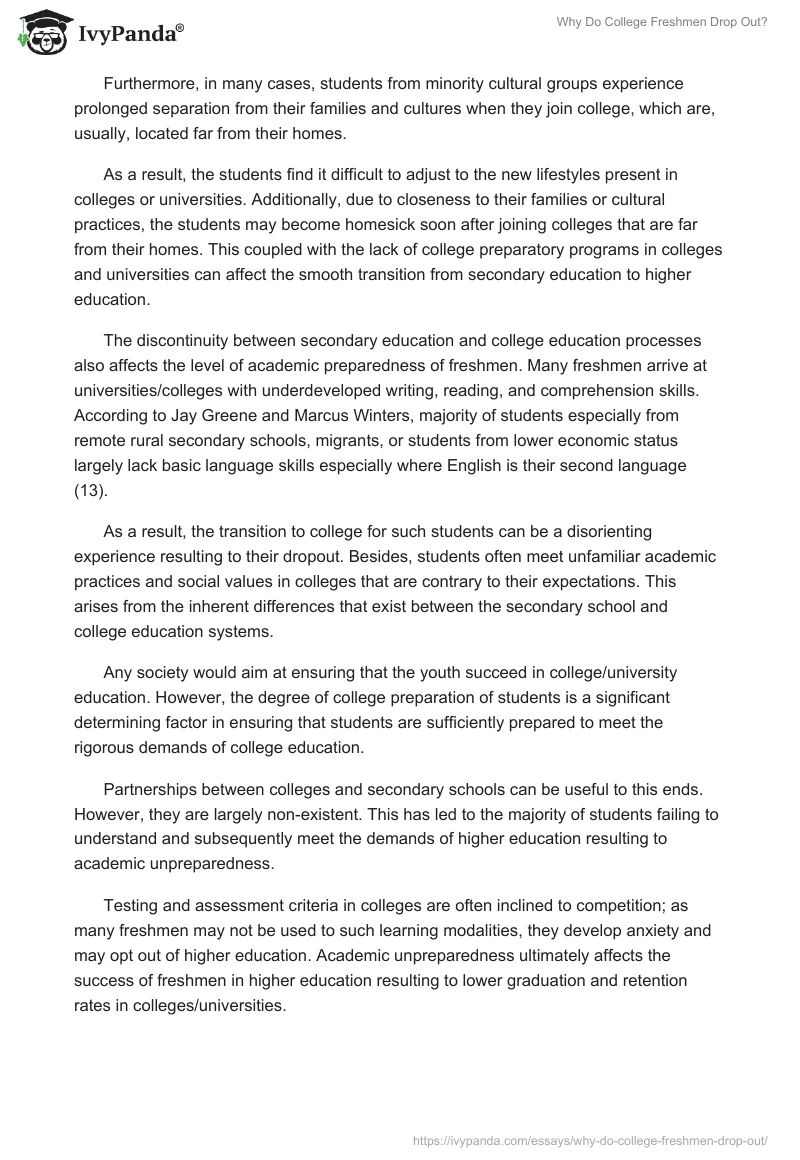Introduction
The prevalence rates of student dropouts from American Universities and Colleges are alarmingly high. This trend has profound effects not only on the labor industry in terms of a decrease in the percentage of skilled labor force, but also on the American society.
The problem of the increasing percentage of college dropouts is also a costly one as States lose enormous sums of money in grants to freshmen, who fail to complete their studies. Moreover, the high number of dropouts results to thousands of workers with enormous loan debts and insufficient skills to meet the dynamics and demands of contemporary labor market.
The high rate of college dropouts begs the question as to why many college students drop out from college. Understanding the reasons for the high attrition rates is essential in the efforts to reduce the high dropout rates. College freshmen drop out for various reasons. Inability to balance classes and work can result to some students leaving school for work.
Additionally, the failure to afford college fees, challenging coursework maybe resulting from academic unpreparedness and failure to establish positive social connections with peers can lead to some students dropping out of college. The increasing percentage of college dropouts can be attributed to academic unpreparedness, unclear career path, and financial constraints.
Academic Unpreparedness
Academic unpreparedness primarily arises from problematic transition from secondary education to college or university education. Students from schools with inadequate academic resources often experience inferior education at elementary and secondary school levels. Thus, the limited academic resources in such schools negatively affect the transition from secondary education to college.
Furthermore, in many cases, students from minority cultural groups experience prolonged separation from their families and cultures when they join college, which are, usually, located far from their homes.
As a result, the students find it difficult to adjust to the new lifestyles present in colleges or universities. Additionally, due to closeness to their families or cultural practices, the students may become homesick soon after joining colleges that are far from their homes. This coupled with the lack of college preparatory programs in colleges and universities can affect the smooth transition from secondary education to higher education.
The discontinuity between secondary education and college education processes also affects the level of academic preparedness of freshmen. Many freshmen arrive at universities/colleges with underdeveloped writing, reading, and comprehension skills. According to Jay Greene and Marcus Winters, majority of students especially from remote rural secondary schools, migrants, or students from lower economic status largely lack basic language skills especially where English is their second language (13).
As a result, the transition to college for such students can be a disorienting experience resulting to their dropout. Besides, students often meet unfamiliar academic practices and social values in colleges that are contrary to their expectations. This arises from the inherent differences that exist between the secondary school and college education systems.
Any society would aim at ensuring that the youth succeed in college/university education. However, the degree of college preparation of students is a significant determining factor in ensuring that students are sufficiently prepared to meet the rigorous demands of college education.
Partnerships between colleges and secondary schools can be useful to this ends. However, they are largely non-existent. This has led to the majority of students failing to understand and subsequently meet the demands of higher education resulting to academic unpreparedness.
Testing and assessment criteria in colleges are often inclined to competition; as many freshmen may not be used to such learning modalities, they develop anxiety and may opt out of higher education. Academic unpreparedness ultimately affects the success of freshmen in higher education resulting to lower graduation and retention rates in colleges/universities.
Unclear Career Path
In both secondary and higher education, career development programs are inadequate. Career development programs guide the student towards making a decision on their future career area. Courses on career development can help students identify their career interest areas to pursue when they join colleges/universities.
However, these programs are largely lacking at secondary school level, which makes students to be uncertain of what course to pursue in their higher education. As a result, most of them end up selecting courses that do not match their career ambitions. It is only when they join college/university that they realize that the selected course does not match their career prospects. This forces them to drop out of college.
In addition, college career fairs that provide opportunities for students to speak with representatives from various corporate and professional fields as well as from other colleges/universities are essential. This allows freshmen to gather pertinent information that helps them in decision-making towards their career interests. Career guidance can also be achieved through secondary school seminars that dwell on diverse topics to prepare students for career choices.
Inadequate instruction or absence of individualized instruction at the secondary level often affects the students’ motivation or interest in some subjects, which ultimately influence their future career choices at the college level. Lack of practical exposure or career advice can result to students having trouble when selecting courses to pursue at college/university level. As a result, the students make uninformed course selection that ultimately forces them to drop out of college.
The approach used in teaching is often uninspiring and largely un-motivating for students. The teachers hold low expectations for the students compared to the high expectations the students have for themselves (Greene, and Winters 15).
As a result, the students are not inspired or motivated to work hard and achieve greater results. Often, homework or group work is not challenging enough. Consequently, the students fail to put more effort to improve their performance in order to graduate. The instruction approach also disadvantages the students with regard to career choices.
Financial Constraints
Students from low socio-economic backgrounds are more likely to drop out of college or fail to graduate because of financial constraints. Credit constraints, whether short-term or long-term, make it increasingly difficult for students to pay tuition fees as well as other costs required for college attendance.
Financial constraints also make it difficult for students to sustain their consumption when enrolled in college/university. As a result, such students take up different jobs to make money to pay for their needs during college semesters. Consequently, time has to be split between class work and jobs, which adversely affect their academic performance. Additionally, constrained students may not experience the same form of college live as students from better economic backgrounds.
Two alternatives exist that can help students pay for college fees: loans or grants and earnings from employments. While loans or grants have the potential of assisting students pay for college fees and other direct college costs, they cannot adequately cater for consumption needs. Hence, economically constrained students have to work during college to meet their college consumption needs. As Daniel Losen puts it, college attrition rates relate to credit constraints (45).
This implies that access to additional loans by constrained students can significantly lower college attrition rates. Losen further contends that, a policy that removes all direct costs for constrained students can be an effective way of addressing credit constraints among college students (49). Credit constraints play a central role in determining the students’ college completion and graduation rates.
Students with adequate financial resources allocate sufficient time to class work and consequently stand a better chance of graduating from college. In contrast, credit constrained students contends with the dilemma of either working to pay the costs of schooling or borrowing, which has impacts on his/her future earnings and personal savings.
The reality of future debts during working years, which is occasioned by higher consumption during college, discourages many students from borrowing. As a result, constrained students fail to join college even though, given funds, they would. Additionally, the prospects of a challenging college life relative to a happy life outside college discourage many constrained students from joining college. This arises because college consumption levels are largely dependent on the student’s financial ability.
Conclusion
The college attrition rates are high. The student dropout rates can be attributed to many reasons among the academic unpreparedness, financial constraints, and unclear career prospects. Many students are unprepared for college education primarily due to problematic transition from secondary education to college education.
Additionally, the absence of career guidance programs leaves many students unmotivated and unsure of their future career prospects. On the other hand, financial constraints affect the student’s ability to pay college fees and afford college his/her consumption needs. These three factors account for the high college attrition rates, which has significant implications for the labor industry and the larger American society.
Works Cited
Greene, Jay, and Winters, Marcus. Public School Graduation Rates in the United States. New York: The Manhattan Institute for Policy Research, 2002.
Losen, Daniel. Graduation Rate Accountability Under the No Child Left Behind Act and The Disparate Impact on Students of Color. Cambridge, MA: Harvard Education Press, 2004.


